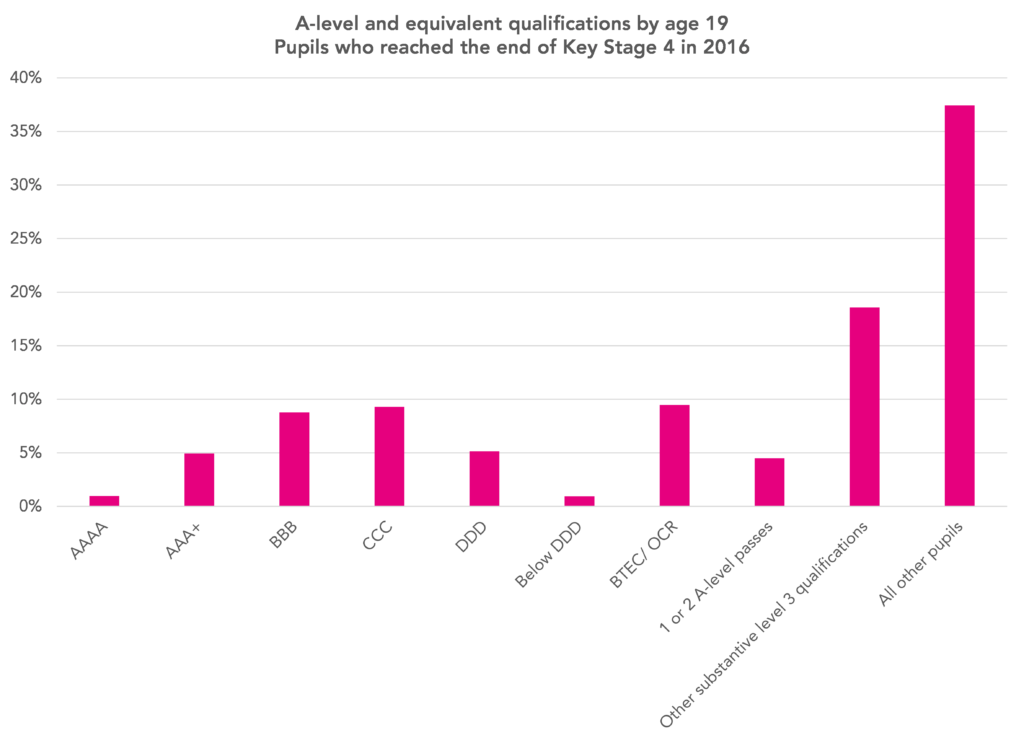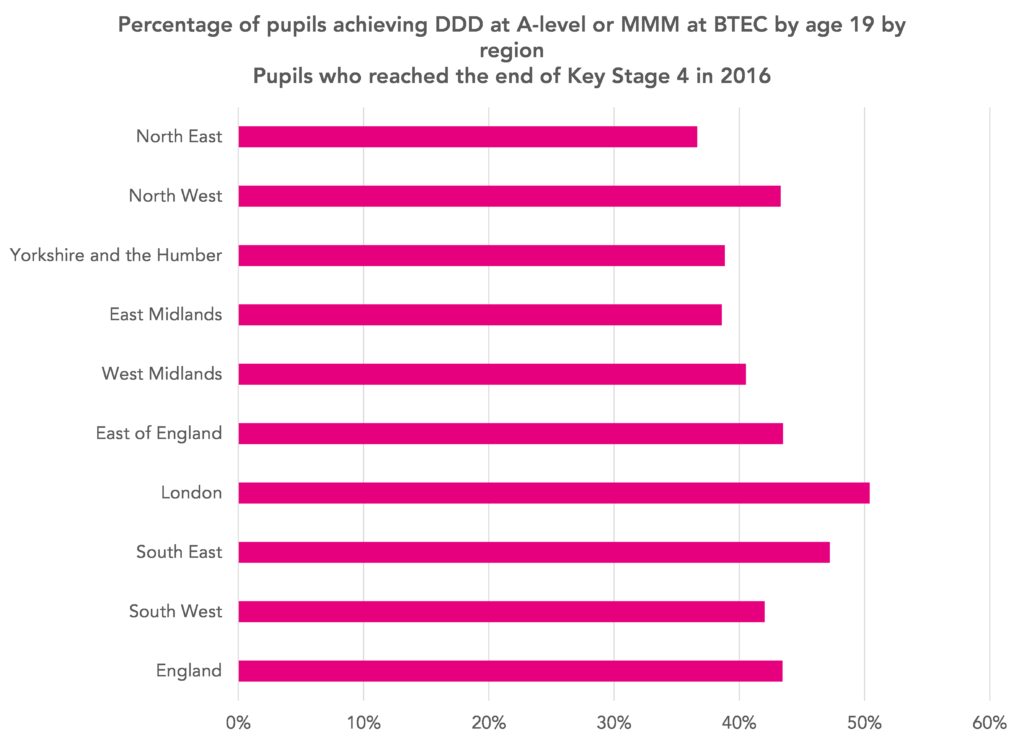Over the last 20 years, efforts have been made by universities to “widen participation”, or in other words to increase the recruitment of previously under-represented groups.
The latest estimates suggest that over 50% of people will experience higher education by the age of 30, and over 40% by the age of 19.
However, proposals in the Augar Review of post-18 education pose a threat to higher education recruitment.
In this blogpost, I’m going to look at one of its proposals; that there should be a minimum entry threshold for higher education.
I have no views on what it should be or whether there should be one. But I thought some data on achievement in A-levels and equivalent qualifications, particularly variations between different areas, would be helpful in thinking about it.
The case for a minimum entry threshold
The Augar Review recommends that “[u]nless the sector has moved to address the problem of recruitment to courses which have poor retention, poor graduate employability and poor long term earnings benefits by 2022/23, the government should intervene. This intervention should take the
form of a contextualised minimum entry threshold, a selective numbers cap or a combination of both.”
Figure 3.14 of the report, which I reproduce below, is cited in evidence.
 The chart summarises salaries in 2016/17 for 2010/11 graduates with different qualifications on entry. This shows (unsurprisingly) that earnings and prior qualifications are related. It is the fact that subsequent earnings tend to be lower for graduates with lower attainment on entry that is part of the evidence used to support the recommendation that a minimum entry threshold should be established.
The chart summarises salaries in 2016/17 for 2010/11 graduates with different qualifications on entry. This shows (unsurprisingly) that earnings and prior qualifications are related. It is the fact that subsequent earnings tend to be lower for graduates with lower attainment on entry that is part of the evidence used to support the recommendation that a minimum entry threshold should be established.
The data
I start with the cohort of young people nationally who reached the end of Key Stage 4 in 2016. I then observe their achievements in Level 3 (A-level and equivalent) qualifications by the end of 2019, at the end of which they are aged 19.
This is all pre-pandemic data, hence grades were lower than those awarded in 2020 and 2021. This may well have implications for setting a minimum entry threshold but I leave those aside for now.
A-level and equivalent qualifications achieved by 19
First of all, I summarise the percentage of young people with different level 3 qualification profiles by 19 using the same categories as the Augar Review [1].
The modal category here is “all other pupils” which covers everyone without substantive level 3 qualifications. To be fair to the Augar Review, many of its recommendations are about increasing opportunity for this group.
In this cohort, relatively few pupils achieved 4 A-levels (AAAA) or 3 A-levels below DDD. This was a cohort affected by both reformed A-levels and funding cuts. Pupils unlikely to achieve grade C at A-level are often steered to other options before being entered.
What might be the minimum entry threshold?
The Augar Review does not recommend any particular threshold. However, it produces several illustrations, one of which is based on achieving DDD at A-level or MMM (Merit) in BTEC/ OCR diplomas.
So for this article, I do the same. I also include A-level and BTEC combinations (treating Merit grades as equivalent to grade D) and achievements in International Baccalaureate and Pre-U qualifications [2].
Overall, 43% of the cohort had met this threshold by age 19. However, only 24% of disadvantaged pupils and 20% of long-term disadvantaged pupils [3] did so.
The Augar Review suggests contextualising the entry bar using individual and area level measures of disadvantage. If an entry threshold is introduced, a fully worked-up version of this will be necessary to understand the potential impact on disadvantaged pupils.
But the blue bars show that disadvantaged pupils are less likely to achieve 2 or more A-level and BTEC passes in any event. Therefore, the pool of disadvantaged potential entrants to higher education who might benefit from contextualisation is relatively small.
In speeches towards the end of his tenure, the previous Secretary of State for Education hinted that grade 4/C passes in English and maths may feature in a minimum entry threshold. But as the chart below shows, almost everyone who achieved the DDD/ MMM threshold achieved grade 4/C in English and maths by age 19.
Regional differences
In the chart below, I show the proportion of pupils in each region [4] who achieve the notional entry threshold of DDD in A-levels or MMM in BTEC/ OCR qualifications by 19.
50% of pupils resident in London achieve this threshold compared to 37% in the North East.
Any attempts at contextualisation would therefore need to disproportionately benefit regions outside London and the South East to level up opportunity between the regions.
In the appendix we have produced statistics on attainment at age 19 by parliamentary constituency. Percentages of pupils meeting the notional threshold range from 22% to 72%.
Summing up
Of course, going to university shouldn’t be seen as the only option open to young people. The remit of the Augar review covered the whole of post-18 education and its recommendations seek to improve both further and higher education. Perhaps more attractive options for technical education will emerge as a result.
However, there is a risk that introducing a minimum entry bar for higher education will reduce opportunity.
Young people should have the opportunity to go to university if they decide it is the best option for them. Providing information on the salaries of graduates is helpful to them making informed decisions although it is by no means the only consideration.
For disadvantaged pupils, getting to university is already a hurdle. By our calculations, less than a third of pupils classified as disadvantaged at the end of Key Stage 4 achieve 2 A levels or 2 BTEC/ OCR passes by age 19. This falls to less than a quarter if a threshold of DDD (in A-levels) or MMM in BTEC were introduced.
[1] I have not included AS levels or any “small” level 3 qualifications (equivalent to 0.5 A levels or less). I have also included OCR Technical Diplomas alongside BTEC National Diplomas.
[2] This definition would need to be updated in future to include T Levels and other less common qualifications used for entry to higher education.
[3] Based on FSM6 status at the end of Key Stage 4. Disadvantaged pupils eligible for free school meals for 80% of school census terms from Reception to Year 11. FSM6 recorded only for pupils in state schools. Pupils in independent schools included in the “all other pupils” category.
[4] Pupils in state-funded schools are allocated to the region where they live. For pupils who attend independent schools, we use the location of the school.
Want to stay up-to-date with the latest research from FFT Education Datalab? Sign up to Datalab’s mailing list to get notifications about new blogposts, or to receive the team’s half-termly newsletter.











Perhaps we need to address why e.g. pupils in the NE are less likely to achieve any threshold we are considering, rather than focus exclusively on contextualised admission to courses for which they might then not be well-prepared? There is an unproblematised statement here that ‘Young people should have the opportunity to go to university if they decide it is the best option for them’: well, maybe, if they have high quality information, know how to use it, and are in a position to benefit from university int the ways they, and the taxpayer, will later value. But I’d argue the taxpayer significantly subsidises university education, so also needs a voice, via government. And the Augar proposals are intended to protect individuals, as well as the taxpayer, from expensive university experiences which benefit no-one. Maybe it’s more important that opportunity is developed for post-school education and for later university entrance, once students have experience and have developed better equipping, maturity, focus and deliberate informed choice?